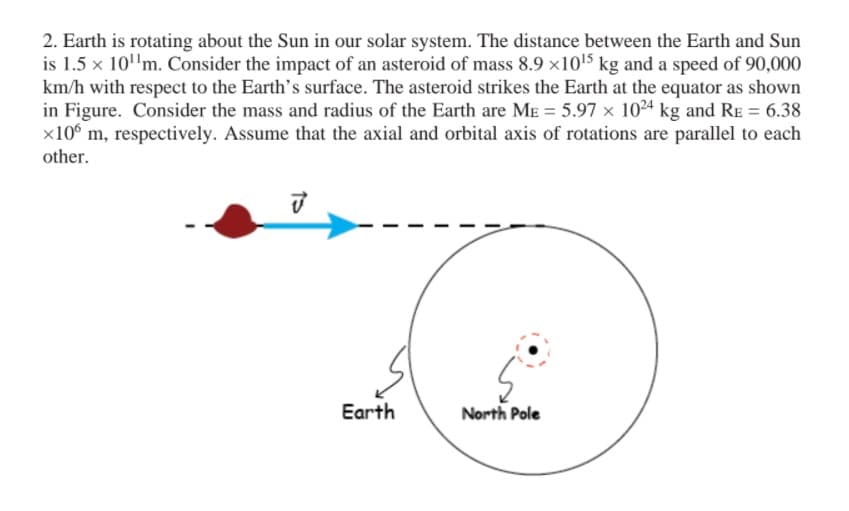Earth is rotating about the Sun in our solar system. The distance between the Earth and Sun is 1.5 × 10^11m. Consider the impact of an asteroid of mass 8.9 ×1015 kg and a speed of 90,000 km/h with respect to the Earth’s surface. The asteroid strikes the Earth at the equator as shown in Figure. Consider the mass and radius of the Earth are ME = 5.97 × 10^24 kg and RE = 6.38 ×10^6 m, respectively. Assume that the axial and orbital axis of rotations are parallel to each other. (a) Calculate the axial and total angular momentum of the Earth. (b) What is the change in the angular velocity of the Earth due to the collision? (c) What is the maximum possible change in the length of a day due to the collision?
Angular Momentum
The momentum of an object is given by multiplying its mass and velocity. Momentum is a property of any object that moves with mass. The only difference between angular momentum and linear momentum is that angular momentum deals with moving or spinning objects. A moving particle's linear momentum can be thought of as a measure of its linear motion. The force is proportional to the rate of change of linear momentum. Angular momentum is always directly proportional to mass. In rotational motion, the concept of angular momentum is often used. Since it is a conserved quantity—the total angular momentum of a closed system remains constant—it is a significant quantity in physics. To understand the concept of angular momentum first we need to understand a rigid body and its movement, a position vector that is used to specify the position of particles in space. A rigid body possesses motion it may be linear or rotational. Rotational motion plays important role in angular momentum.
Moment of a Force
The idea of moments is an important concept in physics. It arises from the fact that distance often plays an important part in the interaction of, or in determining the impact of forces on bodies. Moments are often described by their order [first, second, or higher order] based on the power to which the distance has to be raised to understand the phenomenon. Of particular note are the second-order moment of mass (Moment of Inertia) and moments of force.
Earth is rotating about the Sun in our solar system. The distance between the Earth and Sun is 1.5 × 10^11m. Consider the impact of an asteroid of mass 8.9 ×1015 kg and a speed of 90,000 km/h with respect to the Earth’s surface. The asteroid strikes the Earth at the equator as shown in Figure. Consider the mass and radius of the Earth are ME = 5.97 × 10^24 kg and RE = 6.38 ×10^6 m, respectively. Assume that the axial and orbital axis of rotations are parallel to each other.
(a) Calculate the axial and total
(b) What is the change in the
(c) What is the maximum possible change in the length of a day due to the collision?
(d) How much energy is needed to stop the Earth’s rotation about its axis after the collision?
(e) What would be the moment of inertia of the Earth if the axis of rotation is parallelly shifted so that it touches the equator?

Step by step
Solved in 3 steps with 3 images









